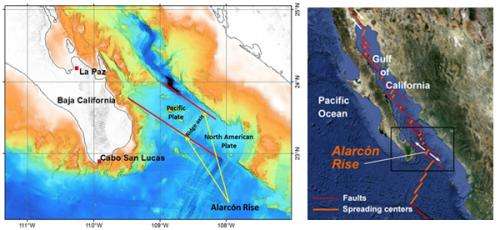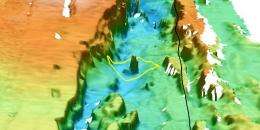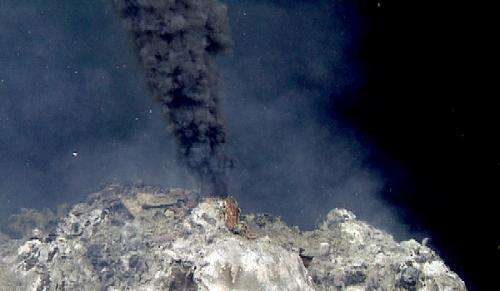These maps show the location of the Alarcón Rise, a 50-kilometer-long (31-mile-long) spreading center at the mouth of the Gulf of California. Along ocean spreading ridges like the Alarcón Rise, the seafloor is splitting apart as lava wells up from underneath. Credit: © MBARI 2012
“As the remotely operated vehicle (ROV) descended into the blue depths above the Alarcón Rise, the control room was abuzz with anticipation," wrote MBARI geologist Julie Martin in her April 22nd cruise log. "Today we [are] planning to dive on one of the strangest environments in the deep sea: a hydrothermal vent field.” Adding to the team’s excitement was the fact that this hydrothermal vent field had never been explored before. In fact, it had only just been discovered... by a robot.
In February 2012, MBARI researchers embarked on a three-month-long expedition to the Gulf of California, the long, narrow body of water between Baja California and mainland Mexico. During the final leg of this expedition, marine geologists studied the Alarcón Rise, an active volcanic region near the mouth of the gulf. Volcanic "spreading centers" such as the Alarcón Rise are hotbeds of volcanic activity, where underwater volcanoes spread lava across the seafloor and hydrothermal vents spout water heated by magma beneath the seafloor to over 550 degrees Fahrenheit.
Given the geological characteristics of Alarcón Rise, chief scientist David Clague and his submarine volcanism research group had a pretty strong suspicion that they might find hydrothermal vents in the area. However, after narrowing the search area to 200 square miles of seafloor, searching for vents would be like looking for a proverbial needle in a haystack. Using an ROV to search vast swaths of the seafloor and entire seamount ridges for vents would be “virtually impossible and incredibly time consuming,” according to Martin.
In 2003, Clague and his colleague Robert Vrijenhoek spent two dives unsuccessfully searching for vents within just a few kilometers of the newly discovered site. At that time, Clague and Vrijenhoek chose their dive sites based on only low-resolution maps of the seafloor and the presence of abnormally warm water in the area.
This time, however, Clague’s team knew exactly where to look. Two weeks earlier, MBARI’s autonomous underwater vehicle (AUV), the D. Allan B. had completed a survey of Alarcón Rise using sound (sonar) to create detailed maps of the seafloor. Shortly into the first ROV dive on this unexplored area, researchers were awed by tall chimney structures nearly identical to those revealed on the AUV’s high resolution seafloor maps.
As expedition leader, David Clague named the first of the newly discovered vent fields the "Meyibó" vent field. In the language of the Kiliwa, the indigenous people of northern Baja California, Meyibó means "time of favorable sun." According to Miguel Tellez, a professor of geology in the Department of Marine Sciences at the University of Baja California (UABC), Meyibó "implies happiness, the celebration of a good harvest, and a time for new learning."
The second vent field and the individual active chimneys in both fields have yet to be named. The chimneys will be named for groups indigenous to Baja California and Sonora, Mexico. The suggestion to use indigenous languages and names of native peoples came from Rigoberto Guardado, a marine science professor at University of Baja California who was one of three Mexican collaborators on this leg of MBARI's Gulf of California expedition.
Hot (550°F), mineral-rich water spews from the seafloor in the hydrothermal vent field discovered on April 28, 2012. The mineral-rich water from this "black smoker" looks like smoke because of the mineral particles that form the hot vent fluid contacts cold seawater. A white bacterial mat is seen on the surface of the chimney below the black smoker. Bacteria use the chemicals in the water as a source of energy. Credit: MBARI 2012
MBARI's mapping AUV is a specialized robotic submersible that flies over the seafloor using three different types of sonar to map features as little as 15 centimeters (five inches) tall. The AUV’s proximity to the seafloor enables its onboard sonars to distinguish fine-scale details that would be invisible to traditional ship-based sonar systems.
Over the past couple of years, the mapping AUV has generated several new discoveries, including documenting a recent underwater lava flow and assessing the risk of oil leaking from a sunken ship off California’s coast. Since 2006, the mapping AUV has discoverd unknown chimneys at three locations along the Juan de Fuca Ridge system off the Washington-Oregon coast.
The successful identification of hydrothermal chimneys using sonar has exciting implications. These spectacular features are of interest to geologists, chemists, and biologists alike. Hydrothermal vents are regions where cool seawater seeps down through cracks in the seafloor where it is heated by the hot magma below the earth’s crust. As the water is heated, it becomes buoyant, rising back towards the surface and spewing out of the seafloor like a geyser.
When hot vent water meets the near-freezing water on the deep seafloor, the dissolved chemicals in the hot water form into mineral particles and precipitate around the vent to form a chimney. These chimneys can grow more than a meter over a period of just a few days. However, they can also become clogged with mineral precipitates, causing the vent to become inactive. Thus, vent fields like those discovered at Alarcón Rise often have numerous “dead” chimneys scattered about.
Hydrothermal vents transport heat and chemicals into the ocean, providing an energy source that supports a robust community of deep-sea organisms, many of which are not found in any other ocean ecosystem. Knowing where and with what frequency hydrothermal vents occur is valuable information for scientists seeking to deepen our understanding of the biology, chemistry, and geology of the seafloor. MBARI’s seafloor-mapping AUV is helping oceanographers spend less time looking for, and more time looking at, these fascinating deep-sea phenomena.
Provided by Monterey Bay Aquarium Institute


























